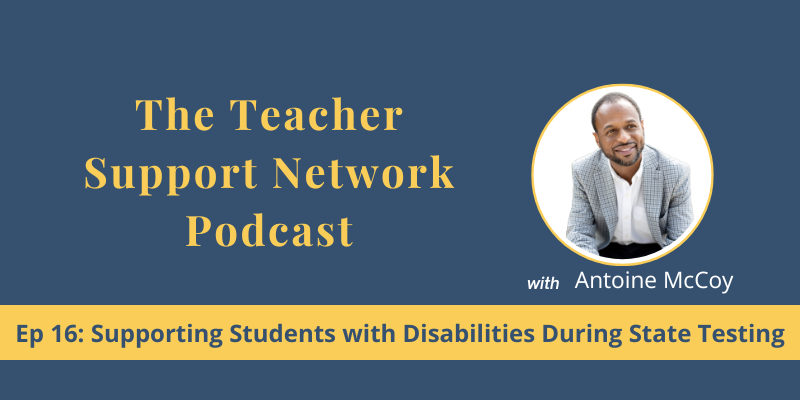
In this episode ~
In this episode of the Teacher Support Network Podcast, we delve into 3 practical strategies to support students with disabilities during state testing.
These tips aim to reduce anxiety and ensure a smoother testing experience for both students and educators during the often stressful state testing season.
Listen in~
00:13 Introduction to Supporting Students During State Testing
00:37 Tip 1: Know the Student's Testing Accommodations
01:28 Tip 2: Prepare Students with Tools and Strategies
02:59 Tip 3: Team Up for Success
04:29 Recap and Final Thoughts
Useful Resources:
Download Gen Ed & SpEd Teachers Collaborative Conversations Guide here.
Join my Newsletter for a weekly dose of practical strategies, tips, resources and inspiration to support you on your teaching journey here.
Transcript
Hey there and welcome to the Teacher Support Network Podcast, where we explore practical ways to support all learners, especially students with disabilities and struggling learners in the mainstream classroom.
Today's topic is on how to support students with disabilities during state testing. We know it's that time of year when state testing usually occurs in your buildings. So whether you're a Gen Ed teacher or a SPED teacher, this episode will give you three tips/strategies you can implement right away to make this season of state testing run a lot smoother. So let's dive in.
Tip/strategy number one is this- know the students’ testing accommodations. That means reading and reviewing the IEPs or the 504 plans carefully before the testing season even hits.
Each plan should have the accommodations that each student is entitled to. Sometimes it's extended time, a quiet testing location, breaks between sections, the use of assistive technology and other sorts of technology, and so forth. It will vary from student to student and from school to school.
These accommodations that are in the IEP or 504 plans aren't suggestions. They're legal requirements and they're designed to help students access the gen ed curriculum, which also includes the state test.
So let's move on to tip/strategy number two- prepare the students with testing tools and strategies.
Let's talk about the student experience during state testing time. For many kids with disabilities, testing is a high stress time, but you can help reduce the anxiety by really helping them practice some of the tests taking process ahead of time.
How can you do this? Let them try out the exact tools they'll be using on a testing day text to speech software, if they have that as a testing accommodation on their IEP. Maybe they can practice using the testing calculator, or just simply how to navigate the testing platform that your district or school is using. Instead of it being a surprise to the students, make it feel routine and not scary.
You can also teach test taking strategies that's tailored to their specific needs. So maybe it's how to pace themselves with extended time, how to take short breaks when their focus starts to fade, or even using scratch paper that may be provided to help solve math problems or to outline written responses before they actually submit it on the official test.
These are little things, but they can have a huge impact on supporting the students to even do better and really show what they know during the state testing time.
Now let's go with our final tip/strategy number three-Team up. So one of the best ways to support students with disabilities is by working together. Gen Ed and SpEd teachers should begin to collaborate early about this topic of state testing so that everyone is properly prepared.
Meet with your school's testing coordinator so the accommodations are set in the system before the testing window opens and closes. Check on the assigned tech tools so everyone's just really clear on who's doing what during that time because it can be a confusing time. It's a lot of different things that are not the day-to-day norm.
Without a proper plan, it can really get things mixed up and cause a lot of unnecessary stress. Gen Ed and SpEd teachers should team up to help create a testing plan that works for their students, particularly their students with disabilities. Who's going to monitor the small group testing room? Who's prepping the tech? What happens if a student gets overwhelmed? Who's gonna be in charge of that? Where will the student go? This kind of planning doesn't take long. But it makes the testing experience smoother for everyone and especially for your students.
Finally, after testing, when it's all said and done, make sure you debrief together as a team to see what worked, what needed some tweaking, and use that info to plan better for the next round or the next year of testing.
So to recap, the three ways to help support students with disabilities during state testing are:
1) Know your students' accommodations.
2) Prepare them with testing tools and strategies.
3) Most importantly, work together as a team.
Supporting students with disabilities during testing isn't about doing more. It’s really about doing what really matters the most.
So, good luck on this season of testing and thanks for tuning into this episode of the Teachers Support Network podcast. Please visit the show notes page for this episode and grab your Gen Ed and SpEd teacher Collaborative Conversations Guide in the resource section. It's free and it's for you to help bridge those conversations between you and your team.
If you have time, please leave a review about the podcast on your favorite podcast listening platform, so it can reach more educators like yourself.
That's it for now. Until next time, keep advocating for your students, keep collaborating, and most importantly, take care of your own well-being in the process. Talk to you soon. Bye now.
Rate, Review, & Subscribe on Apple Podcasts
Enjoy this episode?
Please consider rating and reviewing the podcast! Your support helps me support more teachers - just like you - create inclusive classrooms, foster effective teacher collaboration, and find balance with the demands of teaching in and outside of the classroom
It's easy! Click here, scroll to the bottom, tap to rate with five stars, and select "Write a Review." I'd love to know what was the most helpful or encouraging about the episode!
While you're there, you can subscribe to the podcast if you haven't already. If you're not subscribed, you may very well miss out on future episodes. 🙂 Subscribe now!


